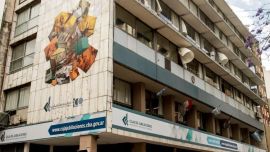Argentina’s inflation woes continue: consumer prices jumped a massive seven percent in August, official data reveals, and have risen 56.4 percent since the start of the year.
The country’s inflation rate remains amongst the highest in the world, data published by the INDEC national statistics bureau confirmed Wednesday.
Argentina’s consumer price index (CPI) has recorded an increase of 78.5 percent over the last 12 months, and given the meteoric trajectory, experts and analysts are expecting the 2022 annual figure to end up breaking the triple-digit mark.
Extraordinary government measures to rein in runaway inflation and the raising of the Central Bank's reference rate to 69.5 percent in August have proved to tamp down runaway price hikes.
Upon taking office last month, Economy Minister Sergio Massa announced that combating inflation represents his and the country’s greatest challenge. Among other decisions, he pivoted on the government’s loose monetary policy and drastically reduced the subsidies of public services.
There appears to be unanimous agreement within the private sector regarding the devastating severity of the crisis. The latest market survey of expectations of the 30 largest consultants and banks in the country, carried out by the Central Bank, yielded an average estimate of an annual CPI increase of 95 percent. Many private analysts, however, are anticipating that the 100 percent barrier will be broken.
INDEC said in a statement that the seven percent rise recorded in August represented a slight easing from the 7.4 percent figure posted in July, which was the highest monthly index of the last 20 years.
Hot spots
Not all products have been hit the same. The segments of the consumer goods market that saw the greatest increases in August were clothing and footwear (9.9 percent) and domestic appliances (8.4 percent), according to INDEC’s report.
A sharp rise in the price of prepaid medicine services was also highlighted, which pushed the healthcare sector up 5.7 percent, while hikes in water and electricity services impacted housing and utilities, which rose 5.5 percent.
Transportation rose 6.8 percent, which experts attributed to a jump in public transport fares – higher in the Greater Buenos Aires region – and the recent rise in fuel prices.
Argentina, Latin America’s third-largest economy, has been experiencing high inflation for years. In 2021, the consumer price index recorded hikes of 50.9 percent for the calendar year.
August’s seven percent figure – the third consecutive month above six percent – “confirms that we are in a new inflationary regime,” said Eugenio Marí, chief economist of the Fundación Libertad y Progreso think-tank.
“This triggered annual inflation to 78.5 percent, the highest since the hyperinflation of 1990,” he observed.
“This behaviour occurs with core inflation running at 78.4 percent per year, while regulated prices rise at a rate of 59.7 percent. In other words, there are prices that continue to be stepped on to moderate the rise in the general index. Closing 2022 with three-digit inflation is a scenario that is becoming more and more likely,” added Marí.
“Already in the INDEC measurement for August, several rises above 100 percent begin to appear; clothing and footwear recorded three-digit year-over-year increases in all regions, and the category of restaurants and hotels also did in Greater Buenos Aires and the Northeast,” said the chief economist of the foundation led by Aldo Abram.
Gloom at the grocery
Putting food on the table is where many Argentines feel inflationary pressures most acutely.
The 10 products at the grocery store that increased the most during August are as follows: onions, which took first place by far with 60 percent, followed by potatoes (32.3 percent), sweet potatoes (31.7 percent), tomatoes (19.4 percent), sunflower oil (18.3 percent), sugar (17.2 percent), bleach (15.9 percent), cotton (15.3 percent), bananas (15.1 percent), and squash (14.2 percent).
The only product that became less expensive in August was lettuce, which decreased in price by 18.1 percent, according to INDEC.
– TIMES/AFP/NA

























Comments